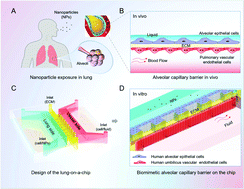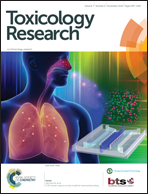A 3D human lung-on-a-chip model for nanotoxicity testing†
Abstract
The prevalent application of nanoparticles (NPs) has drawn intense concerns about their impact on the environment and human health. Inhalation of NPs is the major route of NP exposure and has led to adverse effects on the lung. It is of great concern to evaluate the potential hazards of nanoparticles for human health during pulmonary exposure. Here, we proposed a novel 3D human lung-on-a-chip model to recreate the organ-level structure and functions of the human lung that allow to us evaluate the pulmonary toxicity of nanoparticles. The lung-on-a-chip consists of three parallel channels for the co-culture of human vascular endothelial cells and human alveolar epithelial cells sandwiching a layer of Matrigel membrane, which recapitulate the key features of the alveolar capillary barrier in the human lung. Cell–cell interaction, cell–matrix interaction and vascular mechanical cues work synergistically to promote the barrier function of the lung-on-a-chip model. TiO2 nanoparticles and ZnO nanoparticles were applied on the lung-on-a-chip to assay their nanotoxicity on both epithelial cells and endothelial cells. Junction protein expression, increased permeability to macromolecules, dose dependent cytotoxicity, ROS production and apoptosis were assayed and compared on the chip. This lung-on-a-chip model indicated its versatile application in human pulmonary health and safety assessment for nanoparticles, environment, food and drugs.

- This article is part of the themed collection: Toxicology Research Recent HOT articles


 Please wait while we load your content...
Please wait while we load your content...